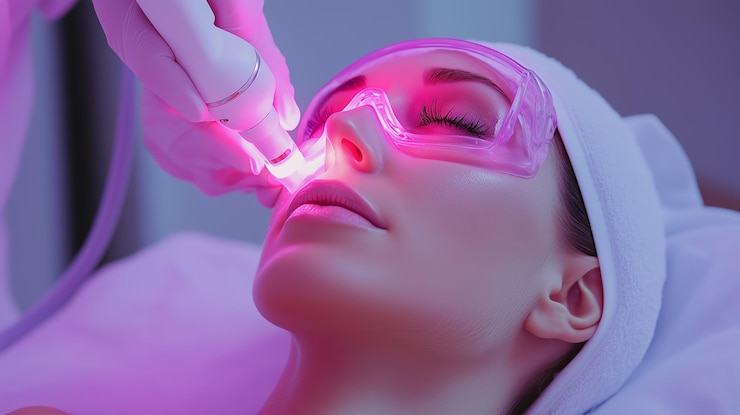In today’s fast-paced world, maintaining youthful and radiant skin can be challenging. Factors such as pollution, sun exposure, aging, and lifestyle choices can contribute to skin damage. Fortunately, advancements in dermatology have led to the development of various laser treatments that offer effective solutions for rejuvenating the skin. This article will explore the benefits of Laser Skincare Treatment in Dubai, how they work, the different types available, and what to expect during and after the procedure.
Understanding Laser Treatments:
Laser treatments use focused light beams to target specific areas of the skin. The light energy is absorbed by the skin cells, promoting various biological responses. Depending on the type of laser used, the treatment can stimulate collagen production, reduce pigmentation, or even remove unwanted hair. The precision of lasers allows dermatologists to customize treatments to address individual skin concerns, making them suitable for various skin types and conditions.
How Laser Treatments Work:
Laser treatments typically involve the following steps:
- Consultation: A thorough consultation with a licensed dermatologist is essential to determine the best treatment plan based on individual skin type and concerns.
- Preparation: The treatment area is usually cleaned, and a topical anesthetic may be applied to minimize discomfort during the procedure.
- Treatment: The laser device is passed over the skin, delivering targeted energy to the desired areas. Depending on the treatment type, sessions can last anywhere from 15 minutes to several hours.
- Post-Treatment Care: After the procedure, patients receive instructions on how to care for their skin to promote healing and maximize results.
Benefits of Laser Treatments:
Improved Skin Texture and Tone:
One of the most significant benefits of laser treatments is the improvement in skin texture and tone. Lasers can effectively reduce the appearance of fine lines, wrinkles, and rough patches by stimulating collagen production. This natural process helps to create smoother and firmer skin, resulting in a more youthful appearance.
Reduction of Pigmentation:
Laser treatments are highly effective in addressing various pigmentation issues, such as sunspots, age spots, and melasma. By targeting the melanin in the skin, lasers can break down excess pigment, leading to a more even skin tone. This benefit is particularly important for individuals who struggle with hyperpigmentation and want to achieve a clearer complexion.
Minimally Invasive with Little Downtime:
Compared to traditional surgical procedures, laser treatments are minimally invasive. Most laser treatments require little to no downtime, allowing patients to return to their daily activities quickly. While some redness or swelling may occur after the treatment, these side effects typically subside within a few hours to a few days.
Versatile Treatment Options:
There are various types of laser treatments available, each designed to address specific skin concerns. Some common options include:
- Ablative Lasers: These lasers remove the outer layer of skin to treat deeper wrinkles, scars, and other severe skin imperfections. They provide dramatic results but may require longer recovery time.
- Non-Ablative Lasers: These treatments penetrate the skin without removing its outer layer. They are ideal for improving skin tone, texture, and fine lines with minimal downtime.
- Fractional Lasers: This innovative technology targets a fraction of the skin at a time, promoting healing and collagen production while minimizing damage to surrounding areas. Fractional lasers are effective for treating scars and stretch marks.
Effective for Various Skin Concerns:
Laser treatments can address a wide range of skin concerns, making them a versatile option for many patients. Common issues treated with lasers include:
- Acne Scarring: Laser therapy can significantly reduce the appearance of acne scars by resurfacing the skin and promoting collagen regeneration.
- Vascular Lesions: Lasers can effectively treat vascular lesions, such as spider veins and rosacea, by targeting the blood vessels without harming the surrounding skin.
- Hair Removal: Laser hair removal is a popular option for individuals seeking a long-term solution to unwanted hair. The laser targets hair follicles, inhibiting future hair growth.
What to Expect During Treatment:
Before undergoing a laser treatment, it’s essential to have realistic expectations. During the consultation, your dermatologist will explain the procedure, including the expected outcomes and any potential side effects.
During the Procedure:
While comfort levels may vary, most patients report minimal discomfort during laser treatments. Some describe the sensation as similar to a rubber band snapping against the skin. An anesthetic cream may be applied beforehand to enhance comfort.
Aftercare:
Post-treatment care is crucial for achieving optimal results. Common aftercare tips include:
- Avoid Sun Exposure: Protect your skin from the sun by using sunscreen and wearing protective clothing, especially during the healing process.
- Moisturize: Keeping the skin hydrated aids in the healing process. Use gentle, fragrance-free moisturizers recommended by your dermatologist.
- Avoid Harsh Products: Steer clear of exfoliants, retinoids, and harsh cleansers for a few days following the treatment to allow the skin to recover properly.
Conclusion:
Laser treatments offer a powerful and effective way to rejuvenate your skin, addressing a variety of concerns from pigmentation to texture. With their minimal invasiveness and quick recovery times, they provide an appealing alternative to traditional surgical methods. However, it’s essential to consult with a qualified dermatologist to determine the best treatment plan for your individual needs. By embracing the benefits of laser treatments, you can achieve healthier, more radiant skin, boosting your confidence and enhancing your overall appearance.





Comments